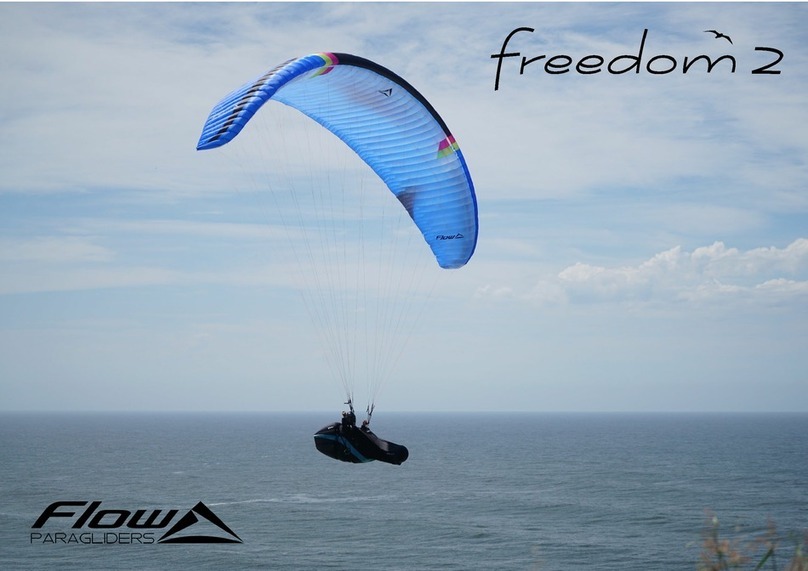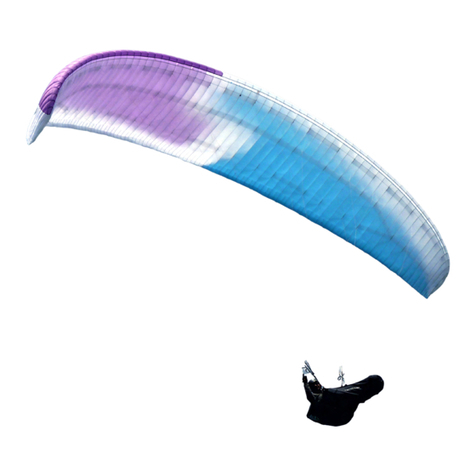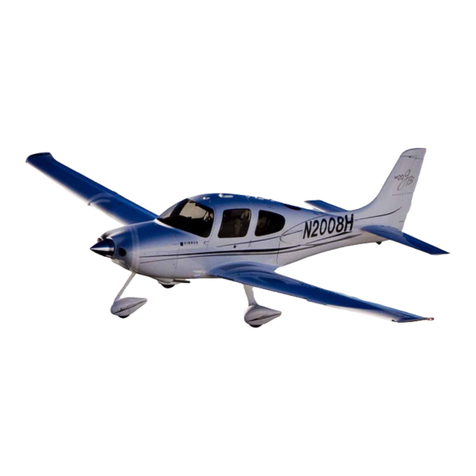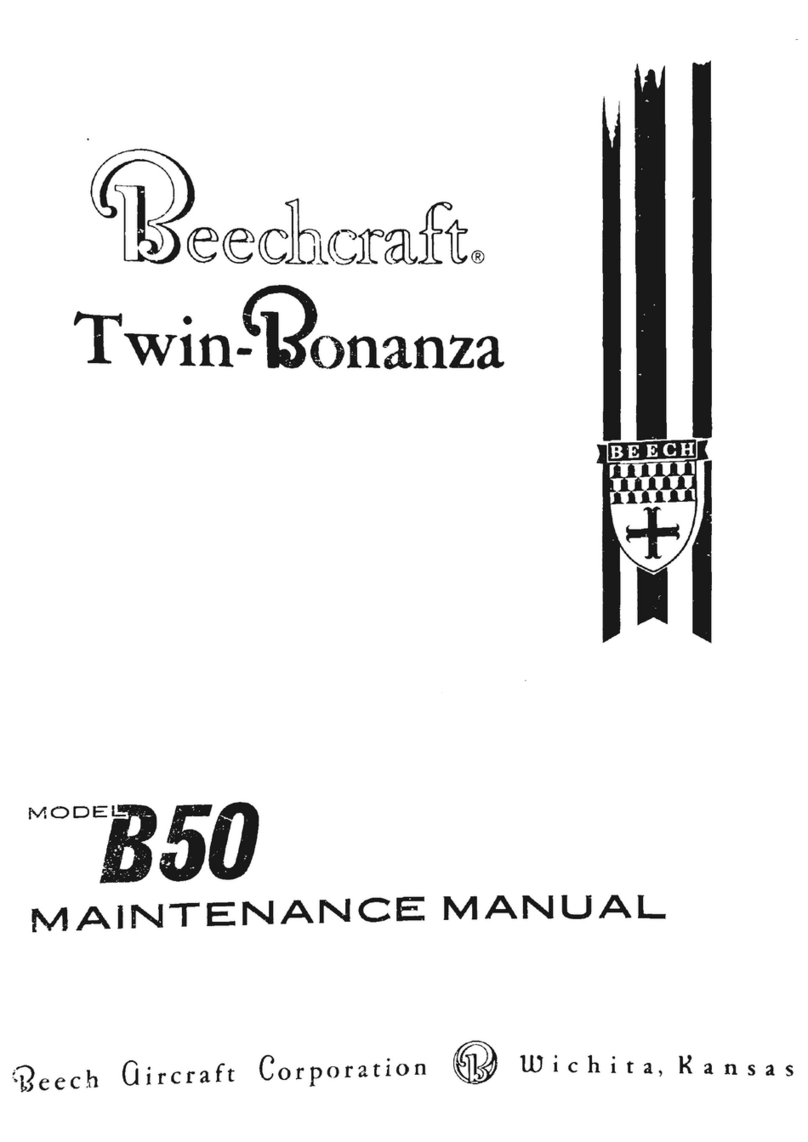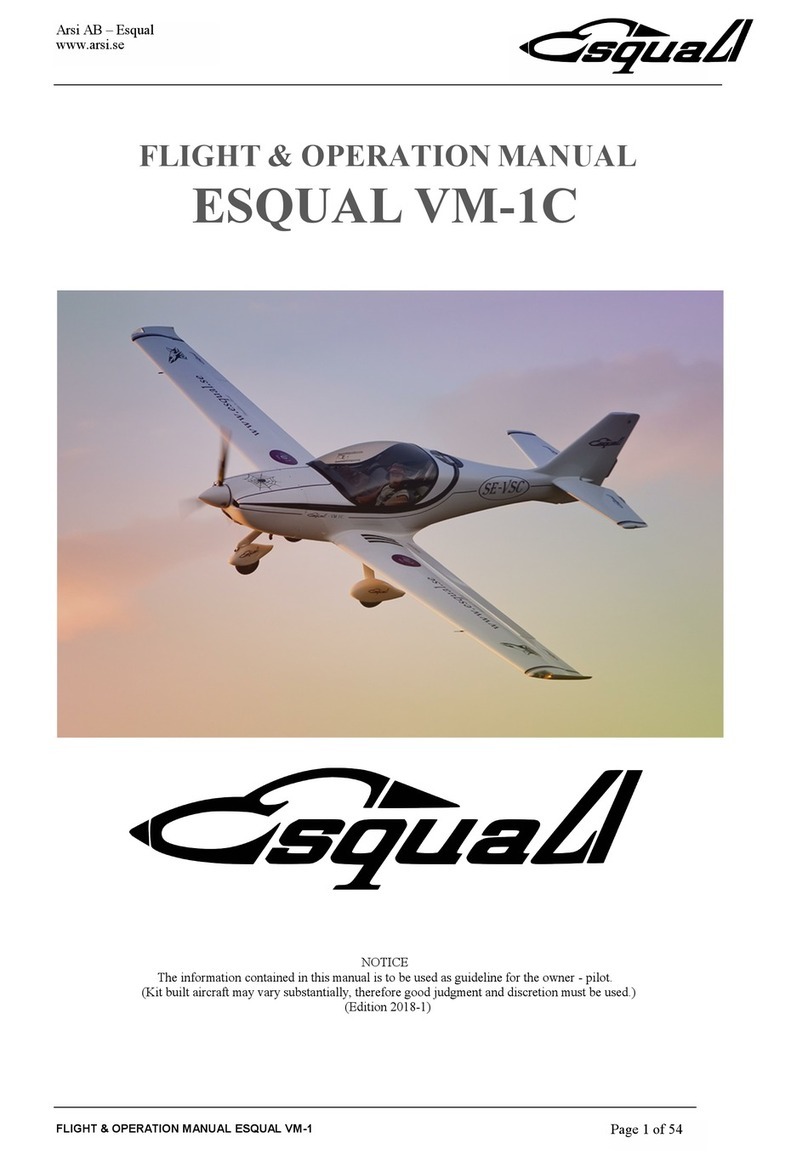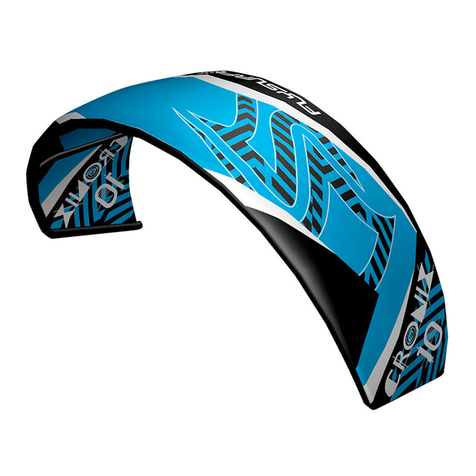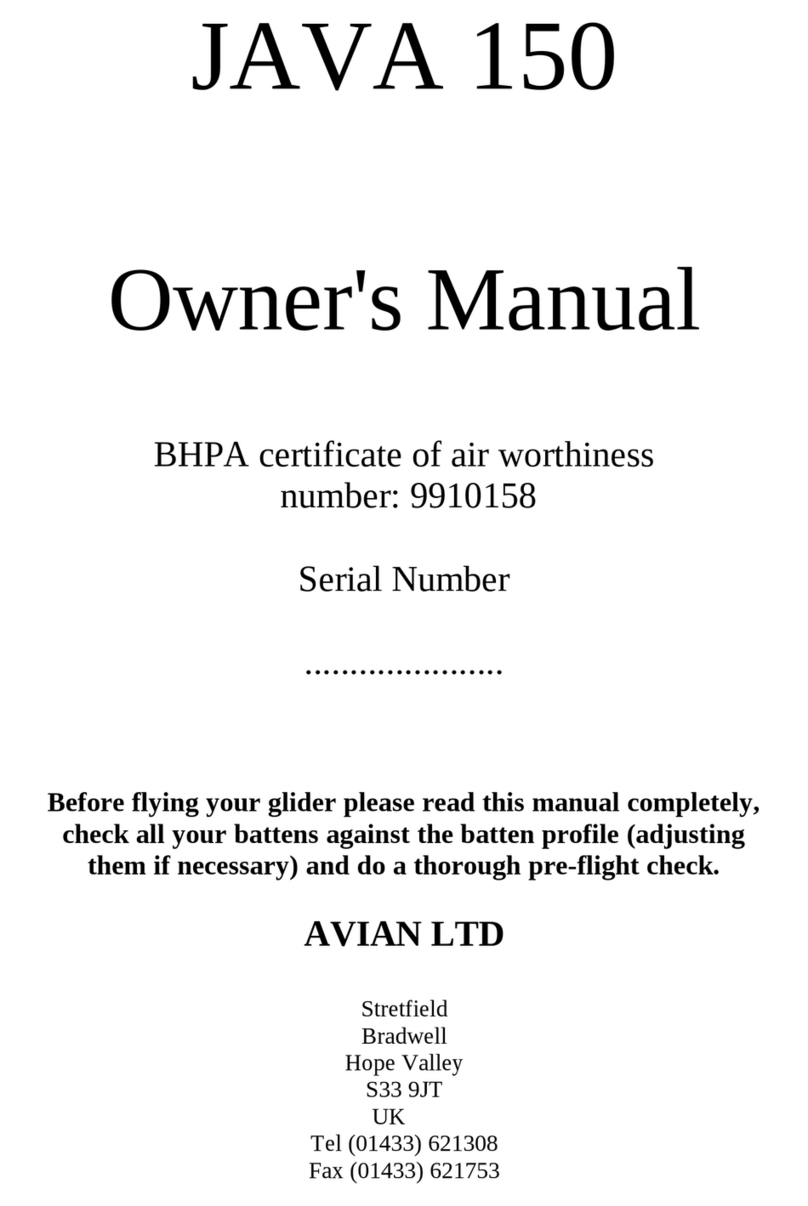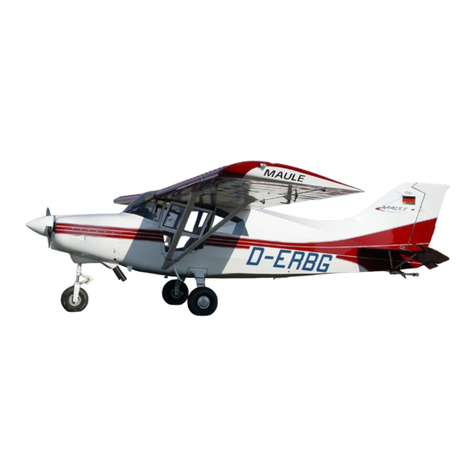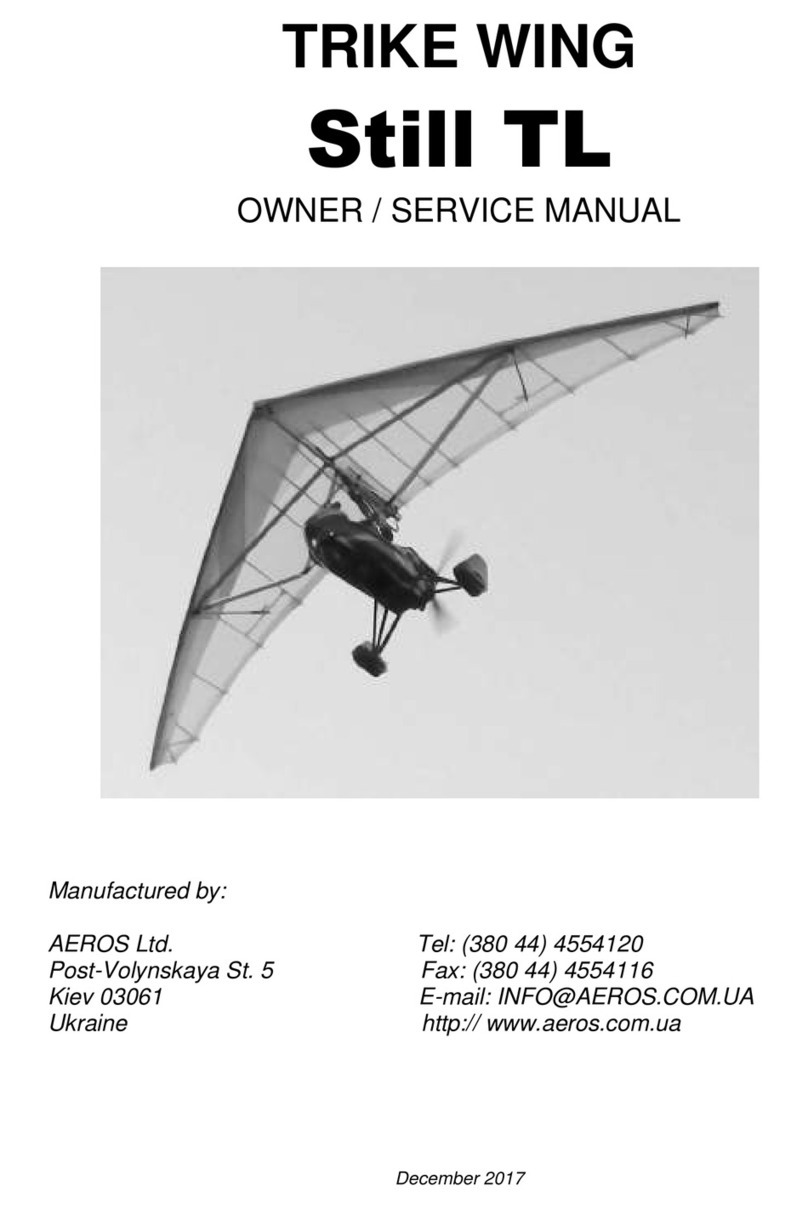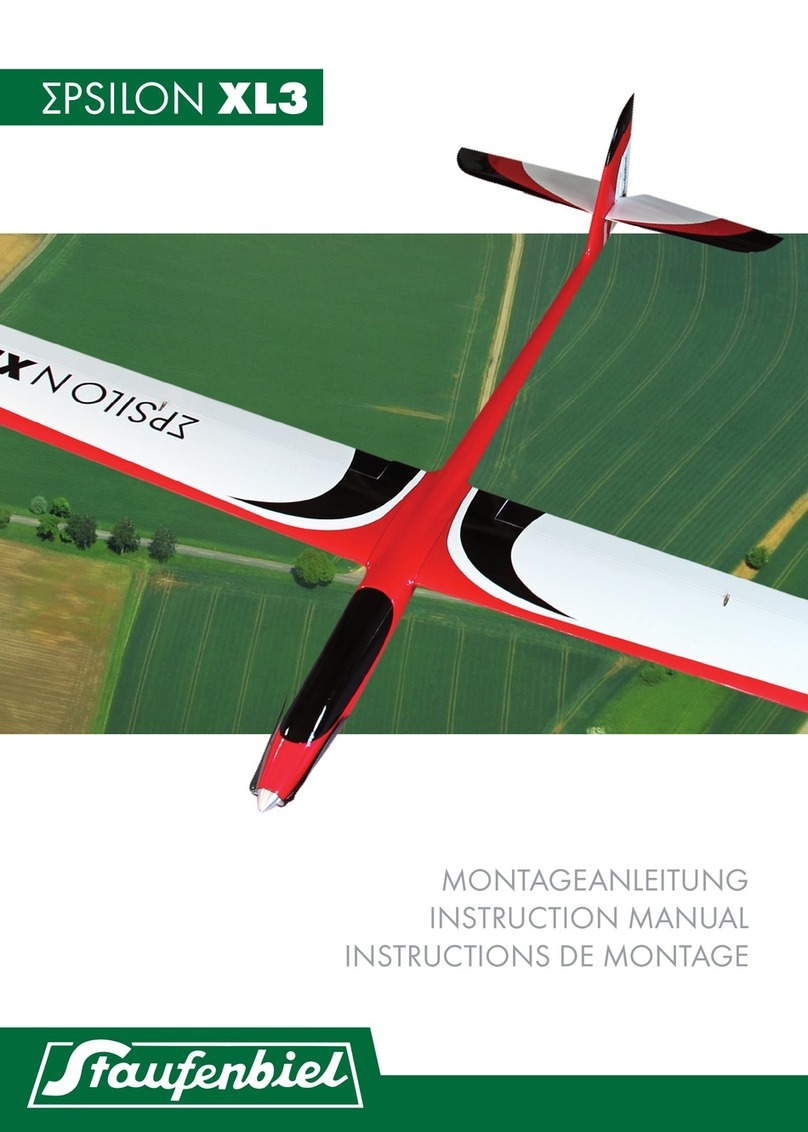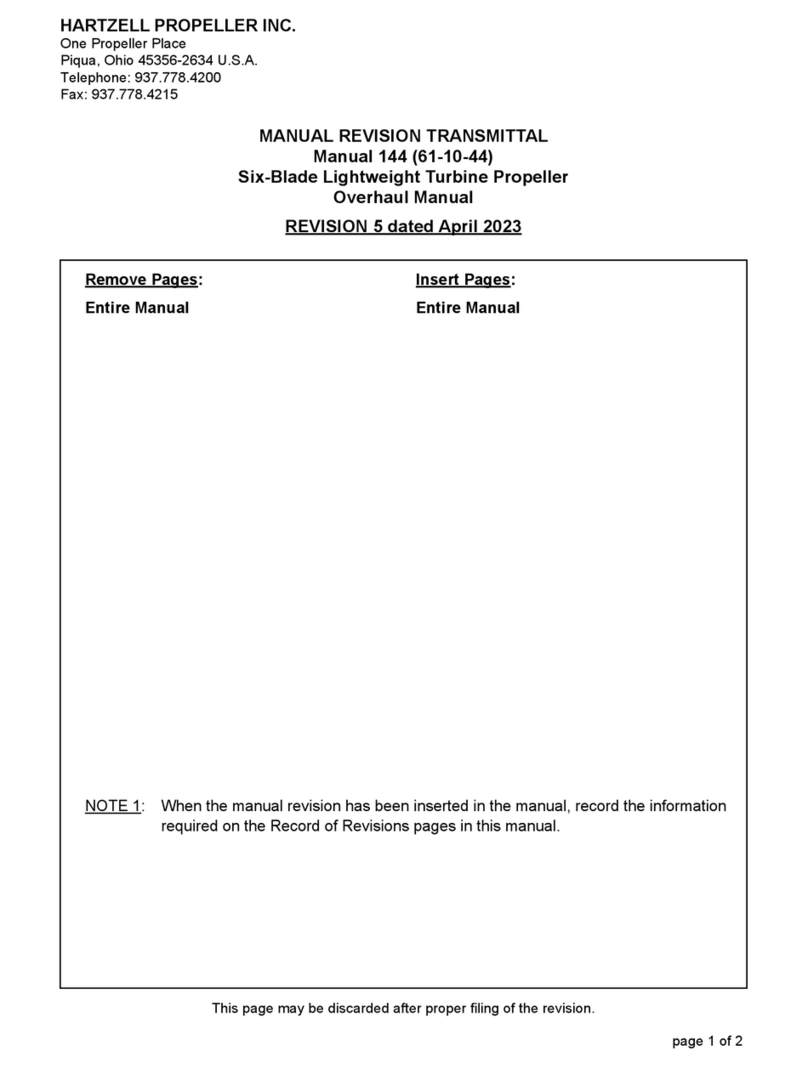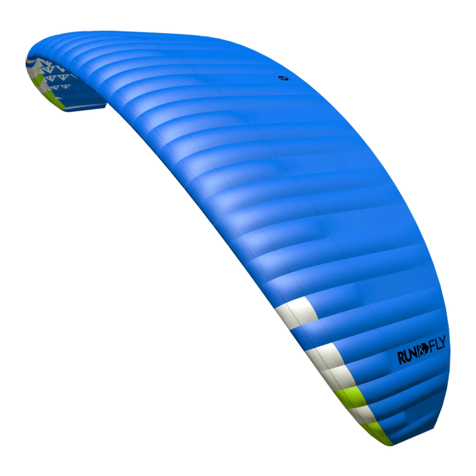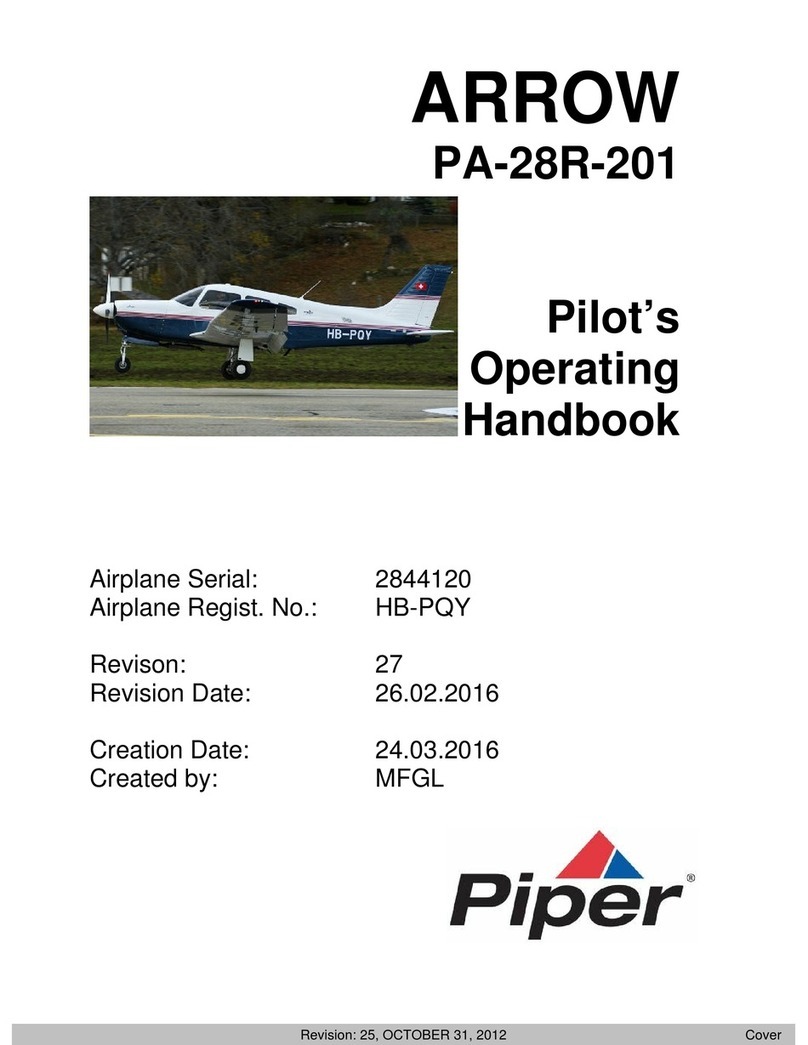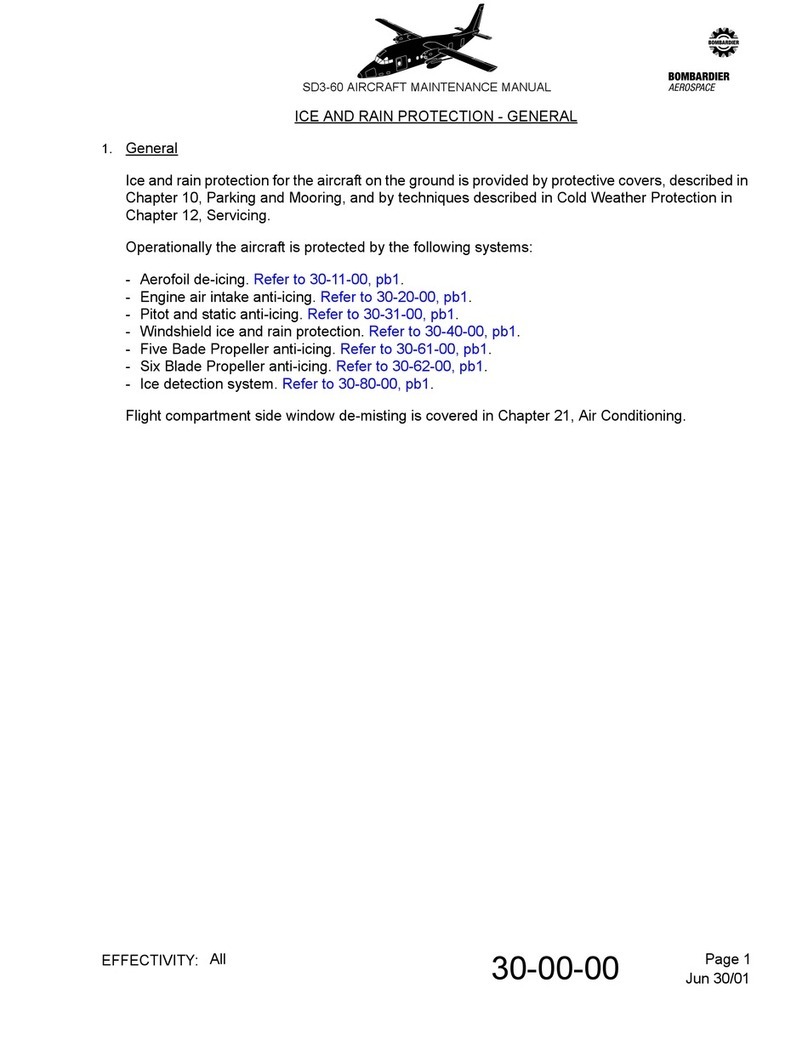Flow Paragliders VISSTA User manual


WELCOME
“Flow is a term used to describe the complete (body-mind-soul) feeling of being so totally engaged in an activity that there is a sense of complete
immersion in the experience. Self-conscious thoughts give way to feeling at one with the activity and the environment, and time is no longer an
ever-present consideration.”
The experience of flying a paraglider is what inspires us. The pure, focused concentration, the feeling of complete immersion with the
environment, and the intrinsic pleasure in the activity itself are all sure signs of the flow experience.
Thank you for flying Flow Paragliders. We hope you will be satisfied with this product and wish you many happy flights. We strongly recommend
that you read this manual before the first flight. This manual is designed to help you to quickly familiarize with this beautiful harness.

Table of Contents
1. General Information ...................................................................1
2. Certification ................................................................................1
3. Pilot’s Profile...............................................................................2
4. Specifications ..............................................................................3
5. Overview.....................................................................................4
6. Adjustment Possibilities...............................................................5
6.1. Adjusting the Chest Belt............................................................. 5
6.2. Adjusting the Shoulder Belts ..................................................... 6
6.3. Adjusting the Lateral Chest Belts .............................................. 6
6.4. Adjusting the Leg Belts .............................................................. 6
6.5. Attaching the Speed Bar ............................................................ 6
7. Installing the Rescue Parachute...................................................6
7.1. Placing the Rescue Parachute into the Inner Container ......... 6
7.2. Placing in Deployment Bag Option A ........................................ 6
7.3. Placing in Deployment Bag Option B......................................... 7
7.4. Installing the Deployment Bag into the Harness ...................... 7
8. Operating Notes ......................................................................... 7
8.1. Operation of the Protector ....................................................... 7
8.2. Maintenance/ Service Life of the Protector ............................. 8
9. Tandem Flights .......................................................................... 8
10. Towing ....................................................................................... 9
11. Behavior in Particular Cases ....................................................... 9
12. Lifetime and Replacement of Parts, Repair Advice....................... 9
13. Maintenance, Inspection & Periodic Checks .............................. 10
14. Storage and Transport .............................................................. 11
15. Nature and Environmentally Friendly Behavior & Disposal......... 11
16. Warranty.................................................................................. 11

1
GENERAL INFORMATION
User manual for VISSTA S, VISSTA M and VISSTA L
This manual offers all the necessary information that will familiarise you with the main characteristics of your new harness.
Flow VISSTA is one of the most comfortable and functional all-round harnesses available on the market at present. We would like to remind you
that it is important to carefully read all the contents of the manual for your new VISSTA.
The VISSTA’s Certification Number is: EAPR GZ-0030/13.
Please note that any changes to the harness will invalidate the result of the certification. Correct usage of the harness is the pilots ‘responsibility.
The manufacturer and distributor do not accept liability for loss or damage as a result of the misuse of this harness. It is the pilot’s responsibility
to comply with legal regulations and to maintain the airworthiness of the harness.
This user manual version V01.01 is dated: 07/2020.
Flow Paragliders PTY LTD | 2 Executive Drive, Burleigh Waters QLD 4220, Australia | info@flowparagliders.com.au | flowparagliders.com.au

2
PILOT’S PROFILE
The VISSTA was designed to be a robust, light, and comfortable open harness with excellent feel in the air. It provides an outstanding flying
experience as well as freedom of movement to perform all the flying manoeuvrers with excellence, which makes it suitable especially for beginners
and XC pilots looking a comfortable open harness. It comes up with an integrated reserve container and a large foam protector. Its weight is low,
and the small packed volume make it a compact all-round harness.
SPECIFICATIONS

3
The VISSTA is a harness for use in a non-motorized paraglider.
For a 2-reserve set-up an external rescue system container (for example a front container) can be mounted. The VISSTA has an integrated one
rescue system container. Certification No.: EAPR GZ-0030/13.
SMALL
MEDIUM
LARGE
MAX. LOAD
120 daN
120 daN
120 daN
HARNESS WEIGHT
3.6 kg
3.8 kg
4.1 kg
HANGPOINT HEIGHT
42 cm
44 cm
46 cm
PROTECTOR SYSTEM
Mousse bag
Mousse bag
Mousse bag

4
OVERVIEW
a) Rescue system container
b) Rescue system release handle
c) Safe T-System with chest belt buckle
d) Lateral chest belt / adjustment buckle
e) Main suspension
f) Eyelet for speed bar line
g) Pulley / ring for speed bar line
h) Shoulder belt with adjustment buckle
i) Suspension for rescue parachute connection bridle (covered)
j) Protector
k) Attachment ring for stirrup/speed bar
l) Fixation for stirrup/ speed bar
m) Rubber band for pulling back speed bar
n) Storage bag
o) deployment bag with release handle
1) Schematic description of how to mount the speed bar (Components partly covered)

5
ADJUSTMENT POSSIBILITIES
The following parts are adjustable: shoulder belts, chest belt, lateral chest belts and leg straps. Due to the versatile adjustment possibilities of the
VISSTA, we recommend in any case that all adjustments and settings are done in a harness hanging simulator before the first flight to guarantee
an optimal comfort.
The buckles of the chest and leg straps are secured against unintentional opening. To open these buckles, push both buttons of the buckle at the
same time.
Adjusting the chest belt
The chest belt is closed with click-lock-buckles. If the chest belt is closed, the falling out safety device (Safe-T-System) is closed as well. The click-
lock buckles must be closed! The length of the chest belt can be adjusted and should not be tightened too much.
Adjusting the shoulder belts
Please note that with correct adjustment, the shoulder belts are felt with light pressure on the shoulders. With the shoulder belts you adjust the
harness to the pilot’s height, and at the same time you adjust the seating position between upright and lying.
Adjusting the lateral chest belts
This is the third step when adjusting your harness. The lateral chest belts can adjust the angle of the seating position. The chest belts can be
adjusted for the most comfortable seating position. Please make sure that the VISSTA is adjusted in a way so the body load is distributed equally
on shoulder belt and lateral chest belt.
Adjusting the leg belts
When you put the harness on, please take care that the click-lock-buckles are closed correctly, and double checked. The leg belts should be
fastened tight but should leave your legs still enough space to move during the take-off and landing phase.
Attaching the speed bar
You can see in the schematic description 1) how the speed bar rope is running. The rope of the speed bar runs down from the risers to the pulley
near the seat board. Then put it through the D-ring with attached rubber band of the opposite side (pullback function of speed bar), placed inside

6
in middle of the seat board (see overview). Then put the rope through the D-ring placed inside at the front of the seat board and put it through
the grommet of the frontal edge. The rope is guided through the small lateral D-rings to the frontal edge of the seat board. Here the line gets
connected to the speed bar.
The length of the speed bar’s line must be adjusted in a simulator before the first flight!
INSTALLING THE RESCUE PARACHUTE
The VISSTA has an inner container with an integrated release handle. Before fitting the rescue parachute, you need to find out the right size of the
inner container. Therefore, you need to know the volume of the rescue parachute. If it is not shown in the parachute manual, you can alternatively
determine the volume of the rescue parachute by checking its weight.
As a rule of thumb multiply the weight by 3. For example: 1500 gr x 3 = 4500 cm3 Volume
You have the choice of two deployment bag sizes for the VISSTA. Only an original deployment bag can be used:
Container size Medium from 3000 cm3 to 6300 cm3
Container size Large from 5000 cm3 to 8500 cm3
Volumes of the AURA rescue parachutes which are compatible with the VISSTA:
Aura M – 5000cm3 Aura L – 6800cm3

7
Placing the rescue parachute into the inner container
After you have chosen the right inner container size, the rescue parachute can be placed into the deployment bag. The steps of packing until you
have reached the shown status below, has to be done as per the rescue parachute manual.
The following guide shows the assembly of an Annular Evo. Other systems can be installed in the same way. Please check if there are special
remarks in your parachute manual. Steerable systems (for example Rogallo systems) can only be installed in the VISSTA with explicit approval of
the rescue parachute manufacturer.
1. Fold the parachute
like an “S” on the
width of the
container, pull out
the Ram-Air-pockets
slightly to the side (if
the parachute is
equipped with Ram-
Air-pockets).
2. Remove the
packing cord

1
Placing in deployment bag option A
3a. Fold the canopy in small S-folds and place it in the deployment
bag. Bundle the lines in 3x3 “8-folds”. Do not bundle the last 60 cm of
lines.
Placing in deployment bag option B
3b. Fold the canopy in big, horizontal S-folds (stack pack). Bundle the
lines in 3x3 “8-folds”. Do not bundle the last 60 cm of lines.
Both options are technically equivalent and can alternatively be used.
Attention: new rubber bands must be used for line bundles and
container with every re-pack!

2
4. Close the deployment bag with the lines. First the right flap with
the upper and lower flap. Depending of the rescue system size, the
inner or outer grommets can be used to adjust the deployment bag
volume.
5. Close the left flap. Also, here you can adjust the deployment bag
volume by using the inner or outer grommets. First close the middle,
then the outside!

3
Installing the deployment bag into the harness
1. Connect the rescue bridle with the harness bridle by looping the
bridles or with a quick link (strength > 2400 daN) and fix the
connection to prevent slipping (for example with a neoprene sleeve).
2. Stow the bridle in the harness container and place the deployment
bag in the harness container. (Lines of deployment bag are facing to
the bottom side)

4
3. Close the container using the loops by the help of 3 packing cords
(a,b,c). Place the handle/container connection in between loop b) and
c). Put packing cord a) through grommet 2). Ten put the 3 packing
cords through the grommets of the elastic strap (I).
4. Close container flap (3) with packing cords a) and b).

5
5. Close container flap (4) with packing cords b) and c). Feed the pins
through the loops.
6. Remove all packing cords. Close pin covers and secure handle with
a 2 daN seal threat (see arrow).
How to secure the release handle:
To avoid an unintentional opening, it is mandatory to use a seal thread in the opening mechanism. This defines a minimum opening force. This
special thread must be put through the loop at the release handle and harness and has to be fixed by a knot. (See picture 6 red arrow)
To secure the pin it is only allowed to use certified material because if the strength of this material is too high the save operation of the rescue
system is not guaranteed. This thread is supplied by us.
Attention: After every installation of a rescue-system in a harness there must be a test if the opening force is between 2 and 7 daN. If harness and
rescue parachute are combined the first time a compatibility check must be performed by an authorized person! The compatibility must be
confirmed in the parachute repack logbook.

6
OPERATING NOTES
Operation of the protector
The VISSTA has a type certified back protector made from a special foam, which is sewn in a nylon fabric cover. Before every take off you have to
check that the protector is completely filled up with air. Especially in low temperatures and after the harness has been stored and compressed for
a while, it may take a little longer to be inflated completely.
During a hard landing the air inside the protector will be compressed and the air will be deflated through the seams of the nylon fabric cover. The
resulting deceleration distributes the impact energy over a longer period and protects the spine from extreme peak loads. The G-forces achieved
in the type certification were very good. However, even the best back protection does not guarantee the prevention of back injuries!
For this reason, the protector should not be used for unnecessary seat board landings. With every use the protector will be less efficient and the
effect of protection a little less over time - even if no damage is visible. If a damage is visible, the protector is not to be used anymore as well as
after a hard landing. In this case the protector must be exchanged or repaired from an authorised dealer/workshop.
Before use of the harness the following points should be checked:
•Are the outer shell of the protector and the entire belt system intact?
•Is the protector fully inflated?
•Are rescue container and release handle properly closed and installed?
•Is the speed system (if installed) properly installed and adjusted?
•Are all harness buckles properly closed and adjusted?
Maintenance / service life of the protector:
The protector is almost maintenance free. Before each take off it should be checked if in right position and fully inflated. Because of to the
mounting position between rescue container and seat board, the Protector is protected from mechanical damage. However, any visible damage
(holes, cracks etc) must be repaired, otherwise the outer shell can break during an impact which ultimately can affect the use of the back protector.
After a hard landing with the use of the protector and if a damage is visible the protector must be repaired or exchanged by the manufacturer or
an authorised dealer/workshop.

7
Tandem flights
The VISSTA is only suitable as a passenger harness. As a pilots’ harness the VISSTA it is not suitable because the rescue system container will not
fit a tandem rescue system.
Towing
The VISSTA is suitable for towing if the main carabiners are used as attachment points for the towing release. There are no separate attachment
points to mount a towing release.
Behaviour in particular cases
During water and strong wind landings the pilot should disconnect himself as soon as possible from the paraglider/ harness after landing. To do
so, please loosen the leg belts and then open the leg and chest buckles. We generally recommend carrying a webbing cutter.
For tree landings, etc. the pilot should first secure himself against a possible crash and should wait for professional help. Contrary to above
recommendations, it is possible that a different behaviour as described is required. The variety of possible situations doesn’t allow a universal or
general advice for the right behaviour. The right behaviour is a case-to-case decision in full responsibility of the pilot.
Lifetime and replacement of parts, repair advice
The VISSTA is designed for high loads and stress. High demands were set in the choice of materials. The lifetime of the harness depends on a high
degree of awareness and treatment of the pilot. We recommend inspecting the harness periodically for signs of wear. If necessary damaged
components must be replaced.
Damaged components may only be repaired by the manufacturer or an authorized workshop. Only original parts are to be used.
If the harness is dirty, clean it with water only. Avoid mechanical stress like rubbing with a brush. Chemical cleaners will damage fabric and webbing.
The only spare parts that are necessary for the VISSTA are rubber bands and maillons, for the connection of the reserve to the harness. Only
approved rubber bands with the size of 30x3x1 mm or 25x3x1x mm should be used. An inexpensive purchase is possible through us.

8
MAINTENANCE, INSPECTION AND PERIODIC CHECKS
The VISSTA is almost maintenance free but it requires a regular check for damage. Regular inspection gives you the guarantee of a full function of
the harness.
Take special care that no dirt gets into the mechanic of the buckles and that all moving parts of the buckles are running freely and are not damaged.
If needed you can oil the buckles slightly.
The maintenance of the protector is described separately.
The harness must undergo a complete check at least after 24 months. The carabiners must be replaced according to the carabiner manufacturer
instructions, no later than after 1000 hours or 5 years. Only original carabiners are to be used. All periodic checks must be documented.
Storage and transport
In order to prevent unnecessary weakening of the harness we recommend the following for storage and transport:
•Avoid high temperatures (for example a closed car in summer)
•Avoid dealing with fire, sharp objects and chemicals in proximity of the harness
•Avoid unnecessary long exposure to sunlight as ultraviolet radiation can destroy the molecular structure of the material
•Avoid contact with saltwater or acid liquids
•If the harness is not in use for a long time, especially the back protector should not be stored compressed. Store the harness in a cool and
dry place.
Nature- and environment friendly behaviour & Disposal
We would also like to emphasise respecting our beautiful nature and looking after your flying sites. Please practice our sport in a way which does
not impact our beautiful nature and environment and don’t leave your litter behind.
If you need to dispose the harness, please don't dispose of it in the normal household waste but in an environmentally responsible way. If you are
unsure, please contact your local council or Flow dealer.

9
WARRANTY
Flow paragliders’ warranty covers any material defects or any production fault for two years or 250 hours since the date of purchase.
The guarantee does not cover:
•Damage caused by misuse
•Neglecting the regular maintenance
•Overloading or misuse of the glider
•Damage caused by inappropriate landings
In case of any doubts regarding the information in the manual contact your FLOW PARAGLIDERS dealer.
For spare parts or information in how to obtain them get in contact with us directly or with your local dealer.
Flow Paragliders PTY LTD | 2 Executive Drive, Burleigh Waters QLD 4220, Australia | info@flowparagliders.com.au | flowparagliders.com.au
Table of contents
Other Flow Paragliders Aircraft manuals



